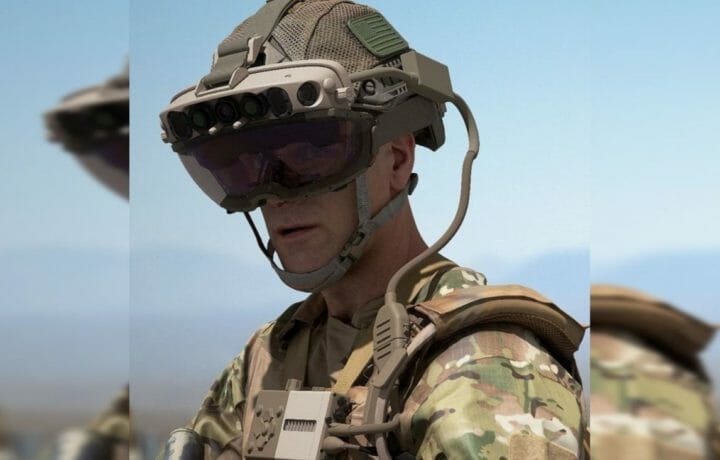Tech giant Microsoft says that its Integrated Visual Augmentation System (IVAS) program would move from rapid prototyping to the production and rapid fielding stage. The IVAS headset, which is based on HoloLens and augmented by Microsoft Azure cloud services, was developed for use with the United States Army. IVAS can address capability gaps in the dismounted close combat force that was identified by the Army leadership via the 2018 National Defense Strategy.
It resembles an oversized pair of goggles, while it integrates key technology systems into one device to provide a single platform for soldiers to fight, rehearse, and train. It provides enhanced situational awareness, while also enabling information sharing and decision-making in a variety of scenarios.
IVAS was developed to balance weight and soldier load with its enhanced capabilities.
“Up until this point IVAS has really been focused on the dismounted Soldiers and getting that fighting goggle right,” said Major Kevin Smith, C5ISR Night Vision and Electronic Sensors Direction (NVESD) Research and Development Coordinator and PM IVAS Platform Integration Directly Responsible Individual (DRI), via a statement. “So in parallel, we in the Night Vision Electronic Sensors Directorate have been working to build-in applications to leverage both new and existing sensors on the vehicles to give the Soldier not just enhanced visual situational awareness, but also C2 [Command and Control] situational awareness while they’re inside of a platform or vehicle.”
As noted by the Army’s announcement, IVAS’s “suite of capabilities leverages existing high-resolution night, thermal, and Soldier-borne sensors integrated into a unified Heads Up Display to provide the improved situational awareness, target engagement, and informed decision-making necessary to achieve overmatch against current and future adversaries. The system also leverages augmented reality and machine learning to enable a life-like mixed reality training environment so the CCF can rehearse before engaging any adversaries.”
HoloLens Moves into Full Production Mode
As the headset moves from prototyping to production phase, Microsoft has been awarded a contract worth up to $21.88 billion over the next decade, according to a report from Reuters. That follows a $480 million contract that the Redmond, WA-tech giant was awarded to develop a prototype in 2018.
The headsets will be manufactured in the United States.
The platform is currently in its third iteration, which is addressing the ruggedness of the system. While previous tests used commercial Microsoft HoloLens 2 headsets, those proved not to be suited to battlefield conditions including inclement weather. A ruggedized version of IVAS was tested last October at Fort Pickett by members of the 82nd Airborne Division as well as some Marines.
After nearly two years in development, the IVAS system is scheduled to be fielded by 2021, and Microsoft announced that it will produce headsets for 120,000 members of the Army Close Combat Force. With this deal, Microsoft will become a more prominent technology supplier to the U.S. military.
In 2019, the company secured a contract to provide cloud services to the Department of Defense (DoD), beating out other tech behemoths including Amazon – with the latter challenging the contract in court.
Fighting and Training Capabilities All in One
The IVAS will utilize augmented reality (AR) technology including targeting cross-hairs that can be linked wirelessly to a smart gun sight on a user’s weapon; while a heads-up display can provide a variety of tactical data including pointers to objectives, the location of friendly units and even alerts on threats.
Additionally, the headset can be used to stream live video downloads from drones, helicopters, ground vehicles and other soldier’s sensors. This could allow warfighters to scope out a situation before their boots are on the ground. It also can provide uplinks to artificial intelligence, which can be used to help identify and report priority targets.
In training situations, IVAS can work much like similar AR efforts, where it can provide simulated enemies and even weapon fire, which would be superimposed on real terrain.
“One of the goals of IVAS was that it’s going to be a fighting goggle as well as a training goggle and we are 100% attempting to bring both to reality,” said SFC Joshua Braly, of the Soldier Lethality Cross Functional Team (SL CFT), which put the headset through the paces.
“This is one of those key moments in our military’s history where we’re able to look back and acknowledge that we’re not where we want to be and we’re willing to make bold strides to get there,” added Braly. “IVAS is without question an effort to do that, and we’re working diligently every day to make this a reality.”




